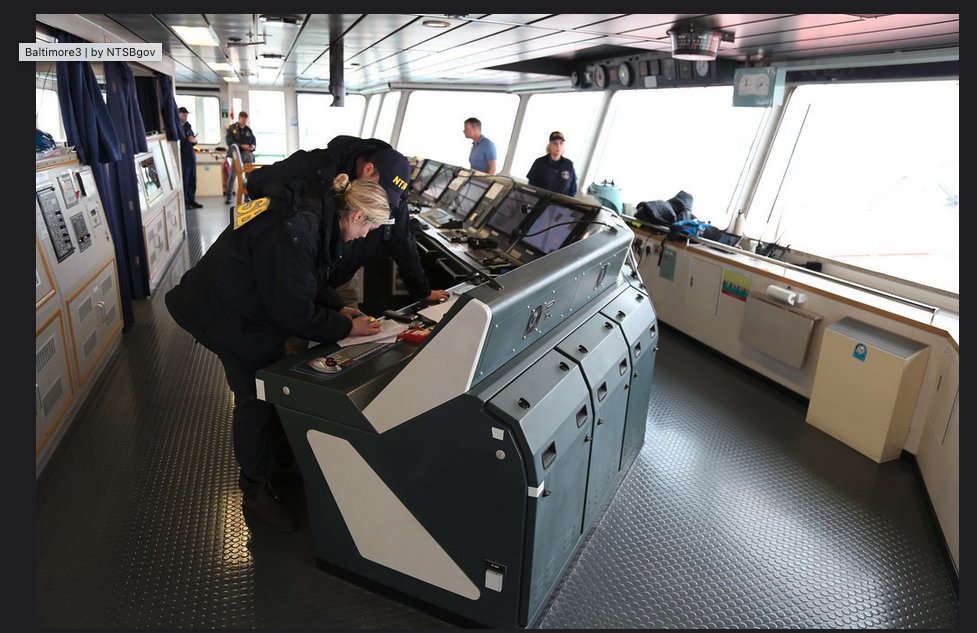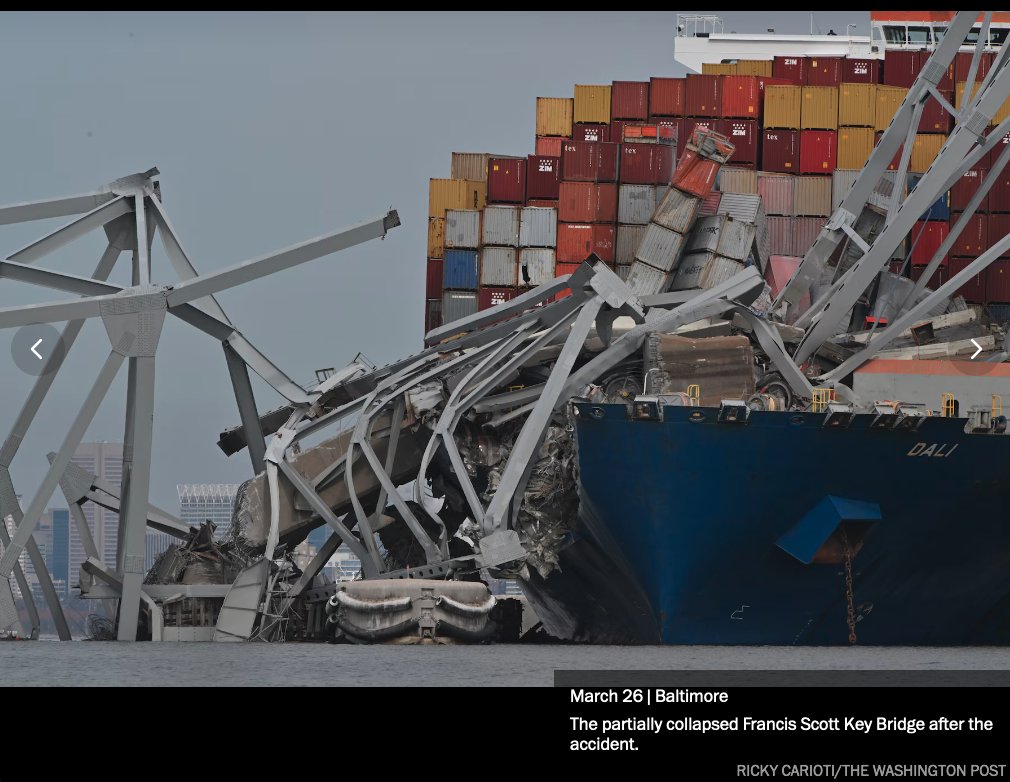On the bridge of the container ship Dali, 4 minutes from disaster, there's one critical moment we haven't heard about yet.
The very moment the ship lost power the 1st time.
What did the pilot do, right then?
His first thought, apparently, was safety — the bridge looming ahead.
—>
⤵️ NTSB photo of the bridge of the Dali...
The very moment the ship lost power the 1st time.
What did the pilot do, right then?
His first thought, apparently, was safety — the bridge looming ahead.
—>
⤵️ NTSB photo of the bridge of the Dali...

2/ The 1st 'event' leading up to the collision that the NTSB notes in its timeline is 1:24:59—when alarms on the bridge indicate power failure.
The ship was without electricity, engine power, lights, navigation, radio.
Dali was dark, literally & in terms of communications.
—>
The ship was without electricity, engine power, lights, navigation, radio.
Dali was dark, literally & in terms of communications.
—>
3/ The first thing the pilot did — apparently within the first 30 to 60 seconds of the ship going dark — was take out his cell phone and call harbor pilot dispatch.
He told his dispatcher: We've lost power, close the bridge. Close the bridge.
—>
He told his dispatcher: We've lost power, close the bridge. Close the bridge.
—>
4/ This is the critical moment. The airline pilot / surgeon moment.
At the first moment disaster starts to unfold, what do you do?
In this case, with Francis Scott Key Bridge looming in the dark just a few ship lengths ahead through the bridge windows, he sounded the alarm.
At the first moment disaster starts to unfold, what do you do?
In this case, with Francis Scott Key Bridge looming in the dark just a few ship lengths ahead through the bridge windows, he sounded the alarm.

5/ The pilot knew he had no radio. He didn't wait to see what would happen in the next 30 seconds. Would the engine room get power back? What systems would come online as the backup power kicked in?
He pulled his cell phone, he called dispatch, he said: Close the bridge.
—>
He pulled his cell phone, he called dispatch, he said: Close the bridge.
—>
6/ I know this from my own reporting, from someone familiar with the pilot's official written account.
This one moment—a minute before the next set of actions is recorded—hasn't been reported elsewhere.
So the events unfolded like this...
—>
This one moment—a minute before the next set of actions is recorded—hasn't been reported elsewhere.
So the events unfolded like this...
—>
7/ ...
1:24:59 Alarms on bridge, power fails on ship 1st time
~1:25:30 Pilot calls pilot dispatch, says ship may hit the bridge, close the bridge
1:26:39 Maryland Transportation Dept records incoming call from pilot dispatch, advising to urgently close the bridge
—>
1:24:59 Alarms on bridge, power fails on ship 1st time
~1:25:30 Pilot calls pilot dispatch, says ship may hit the bridge, close the bridge
1:26:39 Maryland Transportation Dept records incoming call from pilot dispatch, advising to urgently close the bridge
—>
8/ ...
1:27:25 MDTA duty officer radios two units stationed at either end of the bridge, telling them to close the bridge.
1:29:00 to 1:29:33 'Black box' recorder on the ship records the sounds of the Dali crashing into the bridge.
—>
1:27:25 MDTA duty officer radios two units stationed at either end of the bridge, telling them to close the bridge.
1:29:00 to 1:29:33 'Black box' recorder on the ship records the sounds of the Dali crashing into the bridge.
—>

9/ From the moment of the power failure to the moment units were alerted to close the bridge, 156 seconds elapsed.
1:24:59 am to 1:27:25 am.
2 minutes, 26 seconds—from first sign of trouble to the bridge being closed.
That's truly astonishing. That first call saved lives.
—>
1:24:59 am to 1:27:25 am.
2 minutes, 26 seconds—from first sign of trouble to the bridge being closed.
That's truly astonishing. That first call saved lives.
—>
10/ The pilot hasn't been publicly identified yet. We don't know his age, his years on the water, all his actions.
But what happened at that moment—1:24:59—was years of experience kicking in instantly. First priority: Bridge is close, we could hit it, close the bridge.
—>
But what happened at that moment—1:24:59—was years of experience kicking in instantly. First priority: Bridge is close, we could hit it, close the bridge.
—>
11/ The pilot needed to get power back on the ship. He needed to talk to engine room, crew on the bridge & around the ship, move fast to halt or divert the ship.
NTSB transcript says he did do those things.
But first, within seconds, he requested the bridge be closed.
—>
NTSB transcript says he did do those things.
But first, within seconds, he requested the bridge be closed.
—>
12/ That's what he should have done.
Might have been unnecessary, if ship's engines came back on, if emergency measures to change course worked.
He didn't hesitate.
It's that moment that shows experience, competence, and the confidence that comes from those things.
—>
Might have been unnecessary, if ship's engines came back on, if emergency measures to change course worked.
He didn't hesitate.
It's that moment that shows experience, competence, and the confidence that comes from those things.
—>
13/ We don't know most of what we need to about this accident.
Why did the engines on a ship, just leaving port, fail completely?
Was the ship in the right position before that failure?
—>
Why did the engines on a ship, just leaving port, fail completely?
Was the ship in the right position before that failure?
—>

14/ Did the pilot, the captain, the crew, the engine room staff — do what they should have before the ship lost power, and in the minutes after?
But we do know one thing:
—>
But we do know one thing:
—>
15/ At the moment the power failed, at the moment of crisis, the pilot had the preparation, the training, and the presence of mind to do the most important thing first.
Pull out his cell phone & ask that the bridge be closed.
—>
Pull out his cell phone & ask that the bridge be closed.
—>
16/ That's why no cars or trucks were traveling across the bridge when it fell—why no people were traveling across the bridge when it fell.
How critical was the pilot's presence of mind?
—>
How critical was the pilot's presence of mind?
—>
17/ It's 90 seconds from the moment the MDTA duty officer alerts units on the bridge to close it, until the ship's 'black box' starts recording sounds of Dali crashing into the bridge.
90 seconds.
If the pilot had done one thing before calling for the bridge to be closed…
—>
90 seconds.
If the pilot had done one thing before calling for the bridge to be closed…
—>
18/ If the pilot had done one other thing first — of the dozen he urgently needed to do at the moment of crisis — people would have died.
We'll know more in the weeks to come. But I don't think that choice will turn out to be just luck.
We'll know more in the weeks to come. But I don't think that choice will turn out to be just luck.
19/ …Great photos on the tweets in this thread from the Washington Post (@washingtonpost), whose photo journalists have gotten images that really capture the scale of the ship, the bridge, the collision, the human toll.
Full photo gallery here...⤵️
washingtonpost.com/dc-md-va/inter…
Full photo gallery here...⤵️
washingtonpost.com/dc-md-va/inter…
20/ The NTSB's timeline of the events leading up to the container ship Dali hitting the Francis Scott Key Bridge is collected in five tweets @NTSB_Newsroom — 3rd of those 5 linked below, where the critical events begin..
https://twitter.com/NTSB_Newsroom/status/1773156489609282029
• • •
Missing some Tweet in this thread? You can try to
force a refresh




